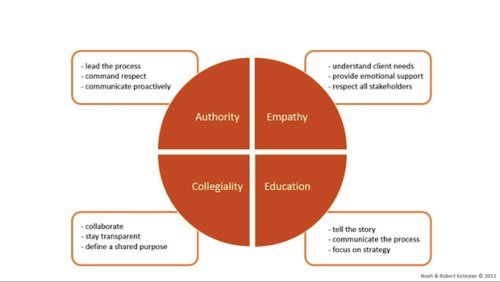Research indicates that, if you want people to listen to you, you typically need four elements taking place:
That’s:
- Authority, or your knowledge and expertise in an area
- Empathy, or your ability to connect with others
- Collegiality, or your tendency to collaborate and stay transparent
- Education, or your background and ‘vetting’
This four-pronged model is based on getting others to listen to you. But if you want to improve listening skills — of your leadership, or your team, or another subset — towards customer growth, how do you do that? It turns out the models are very similar.
Improve Listening Skills: The Background Approaches
This Fast Company article recommends five ideas to improve listening skills, including:
- Be fully in the moment
- Put yourself in their shoes
- Pick up key points from the speaker and let them know you did
- Practice active listening
- Develop curiosity and a desire for continued growth
Similarly, Forbes once ran a story on ’10 steps to effective listening’ — which is ranked very high in Google search results — and recommends the following:
- Face the speaker and maintain eye contact
- Attentive, but relaxed
- Keep an open mind
- Listen to the words and visualize what the speaker is saying
- Don’t interrupt with your solutions
- Wait for the speaker to pause to ask questions
- Ask questions only to ensure understanding
- Feel what the speaker is feeling
- Give the speaker regular feedback
- Pay attention to nonverbal cues
If you combine these two lists, then, the Fast Company one (the first set of bullet points) is a little bit ‘higher-order’ or umbrella view of how to improve listening skills. The Forbes list is a bit more functional and moment-by-moment. There is a way to find the intersection point towards customer-driven growth, however.
Improve Listening Skills: Your Company’s Leadership
This is a crucial step in any type of customer-driven growth. Let me explain it with two visuals courtesy of Linda Hill’s TED Talk on collective creativity.
Here’s the first visual, which is how most companies are organized:
The blue person at the top is a person with the most power and decision-making ability. You can think of it as one person or let it represent the whole C-Suite; it doesn’t matter. Just understand that blue = power. But because of how this company is organized, the widest row of yellow people — at the very bottom — is closest to the customers. So the people with power, thus, are furthest from the customer. That makes it pretty challenging for the decision-makers to be listening to the customers, right?
Here’s a second visual:
This is where you can invert the pyramid. But there’s a crucial element to understand here. A corporate pyramid will never actually get inverted. No senior decision-maker is going to place themselves below everyone else in a hierarchy. So this second slide is theoretical, but it’s very important — it’s a way to think about how your CEO or CMO or whoever can improve listening skills, get closer to the customer, and make decisions based off of that.
I’ve written about this in different ways in both my books and countless times on this blog too. When we talk about how to improve listening skills, we’re talking about two key customer experience concepts:
- One-Company Leadership, where there’s alignment and smashed silos and executives are listening to each other and listening to customers
- Alignment Around Experience, where customer experience is viewed as a driving force of financial growth
The alignment point of those two concepts, with an additional focus on Customer Listening Path, will help improve listening skills of your senior leadership. I recently wrote a post about how organizational decision-making drives customer loyalty, and that’s a good place to start to understand the notion of connecting silos and moving to one-company leadership. That’s a crucial tactic to make sure leaders are really listening — both to each other and to customers. Without a push towards one-company leadership, it’s possible most leaders are listening to their direct boss (the CEO) about what metrics he/she expects from their silo, then only communicating on those metrics back to their teams. In this way, customer experience isn’t the focal point for growth — each silo has a different focal point, which means a customer’s experience is going to be very disjointed. You’ll then lose that customer. It’s not the way to run a business in 2016, and it all starts with learning how to improve listening skills and align/connect silos and customer experience.
I’ve also written about growing leadership listening skills before, so check out that post as well.
Improve Listening Skills: How Do You Listen To Customers?
I wrote a post a few weeks ago that gives examples of listening to customers from three leading companies. There are dozens of approaches to listening to customers better, and many of them are rooted in those bullet point lists up at the top of this post — such as “Put yourself in their shoes.” That’s a crucial one. A good customer experience is designed in part by understanding the pain points that a customer might experience along the way. As you find those pain points, you can eliminate them. The fewer there are, the happier a customer is likely to be. That’s obviously great for growth.
Social media is a huge part of this, because that’s where conversations are happening about your brand minute-by-minute. It’s important to understand the connection between customer experience and social media, even if you’re an older-school company that doesn’t fully embrace social yet. (You should, though.) Social is a great place to do customer listening — and to regularly offer customers feedback, which will show that you’re listening.
Improve Listening Skills: Big Takeaway
Listening skills relevant to customer growth involve three legs of a key triangle:
- Senior leaders of a company listening to each other and not breaking out silo-by-silo
- Senior leaders of a company listening to employees and making sure good ideas aren’t getting lost in process
- An entire company listening to customers and making decisions in their best interests
If those three things are consistently being achieved, you can create a customer-driven culture of growth. If even one leg of the triangle isn’t working, that becomes much more challenging.
What other approaches have you seen to improve listening skills, either among executives or towards customers?






